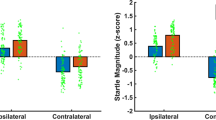Abstract
The present study was conducted to demonstrate classic conditioning in electrodermal (ED) and heart rate (HR) responses by using a nonaversive reaction time (RT) task as unconditional stimulus (US). Three groups of 12 subjects each were studied to test the efficacy of this US procedure by varying the essential components of the RT task-US between groups. Eight seconds differential delay conditioning was applied in each group. Simple geometric features (square, cross) displayed on a TV screen were used as CS+ and CS−. RT task consisted of a nonaversive tone (72 dBA, 1000 or 1200 Hz) and a motor response (pressing a button with the left index finger). Subjects were asked to respond as soon as the tone stimulus was presented. The three groups received different stimulus sequences during the 16-trial acquisition phase only. In one group (Group C1), CS+ was followed by a tone to which subjects were to respond, whereas CS− was not followed by a tone. Similarly, in a second group (Group H), CS+ was followed by a tone, whereas CS− was not; however, subjects of Group H (habituation group) were not required to respond to the tone. In a third group, (Group C2) CS+ was followed by a tone to which subjects were to respond, while CS− was followed by a different tone requiring no response. According to analysis of Group C1 data, differential conditioning was obtained in each response measure. Group H displayed habituation in each response measure obtained. In Group C2, differential conditioning was obtained in the second latency window of ED responses only. In all trials, first-interval anticipatory ED responses and HR responses did occur during acquisition, but were not differentiated with respect to the CS conditions. Although the results of Group C2 need further exploration, differential conditioning of HR and in all latency windows of ED responses was demonstrated by the use of a nonaversive RT task as US.
Similar content being viewed by others
References
Baer, P. E., and Fuhrer, M. J. (1969) Cognitive factors in differential conditioning of the GSR: Use of a reaction time task as the UCS with normals and schizophrenics.Journal of Abnormal Psychology, 74, 544–552.
Bohlin, G., and Kjellberg, A. (1979) Orienting activity in two-stimulus paradigms as reflected in heart rate. In Kimmel, H. D., van Olst, E. H., and Orlebeke, J. F. (Eds.),The Orienting Reflex in Humans. Hillsdale, New Jersey: Erlbaum, pp. 169–199.
Fuhrer, M. J., and Baer, P. E. (1970) Preparatory instructions in the differential conditioning of the galvanic skin response of schizophrenics and normals.Journal of Abnormal Psychology, 76, 482–484.
Greenhouse, S. W., and Geisser, S. (1959) On methods in the analysis of profile data.Psychometrica, 24, 95–112.
Kirk, E. R. (1969)Experimental Design: Procedures for the Behavioral Sciences. Belmont: Brooks/Cole.
Lykken, D. T., and Venables, P. H. (1971) Direct measurement of skin conductance: A proposal for standardization.Psychophysiology, 8, 656–672.
Maltzman, I., Gould, J., Barnett, O. J., Raskin, C., and Wolff, C. (1977) Classical conditioning components of the orienting reflex to words using innocuous and noxious unconditioned stimuli under different conditioned stimulus-unconditioned stimulus intervals.Journal of Experimental Psychology: General, 106, 185–212.
Öhman, A. (1983) The orienting response during Pavlovian conditioning. In Siddle, D.A.T. (Ed.),Orienting and Habituation: Perspectives in Human Research. Chichester: John Wiley & Sons, pp. 315–317.
Öhman, A., Fredrikson, M., Hugdahl, K., and Rimmö, P. A. (1976) The premise of equipotentiality in human classical conditioning: Conditioned electrodermal responses to potentially phobic stimuli.Journal of Experimental Psychology: General, 105, 313–337.
Öhman, A., Fredrikson, M., and Hugdahl, K. (1978) Orienting and defensive responding in the electrodermal system: Palmar-dorsal differences and recovery rate during conditioning to potentially phobic stimuli.Psychophysiology, 15, 93–101.
Pendery, M., and Maltzman, I. (1977) Instructions and the orienting reflex in “semantic conditioning” of the galvanic skin response in an innocuous situation.Journal of Experimental Psychology: General, 106, 120–140.
Siddle, D.A.T., Remington, B., and Churchill, M. (1985) Effects of conditioned stimulus pre-exposure on human electrodermal conditioning.Biological Psychology, 20, 113–127.
Woodworth, R.S., and Schlossberg, H. (1954)Experimental psychology. New York: Methuen & Co.
Author information
Authors and Affiliations
Rights and permissions
About this article
Cite this article
Lipp, O.V., Vaitl, D. Reaction time task as unconditional stimulus. Pav. J. Biol. Sci. 23, 165–172 (1988). https://doi.org/10.1007/BF02700429
Issue Date:
DOI: https://doi.org/10.1007/BF02700429




